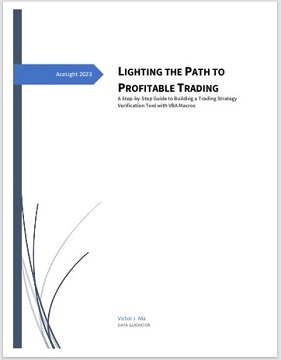Forward Testing: How to Give Your Stock Trading Strategy a Test Drive
|
|
Let's face it - stock trading can be a bit like playing a game
of roulette. Except instead of betting on red or black, you're betting on
the rise or fall of stocks. And instead of a croupier spinning a wheel,
you've got Elon Musk tweeting about Dogecoin. It's no wonder that some
traders are turning to forward testing to try to increase their odds of
success. Because let's be real, sometimes the only thing you can do in the
stock market is hope for the best and pray that your portfolio doesn't tank
faster than a lead balloon.
Stock trading is an exciting and
potentially profitable endeavor. However, the key to success is having a
solid trading strategy that is proven to work over time. One way to test the
effectiveness of a trading strategy is through forward testing. In this
article, we will explore the concept of forward testing and provide some
examples of how it can be used in stock trading.
What is Forward
Testing? Forward testing is a method of evaluating a trading strategy using
real-time market data. It involves implementing a trading strategy in a live
market environment and tracking its performance over a specified period.
Forward testing is different from backtesting, which involves testing a
trading strategy using historical data to see how it would have performed in
the past.
The main advantage of forward testing is that it provides a
more accurate picture of how a trading strategy will perform in a real
market environment. It takes into account the dynamic nature of the market
and the fact that prices can fluctuate rapidly. As a result, forward testing
can help traders identify potential flaws in their strategy and make
adjustments to improve its performance.
Now, let's look at some
examples of how forward testing can be used in stock trading.
1.
Moving Average Crossover Strategy
The moving average crossover
strategy is a popular trading strategy that involves using two moving
averages of different periods to identify buy and sell signals. The strategy
involves buying a stock when the shorter-term moving average crosses above
the longer-term moving average and selling when the shorter-term moving
average crosses below the longer-term moving average.
To forward test
this strategy, a trader would first determine the specific moving averages
they want to use (for example, a 50-day and 200-day moving average). They
would then implement their trading strategy in a live market environment,
using real time data to simulate trades and track the performance of the
strategy over time.
During the forward testing process, the trader
would monitor the performance of the strategy and adjust it as needed. For
example, if the strategy was not generating the desired results, the trader
may adjust the period of the moving averages or implement additional
indicators to improve their accuracy.
2. Breakout Trading Strategy
The breakout trading strategy involves buying a stock when it breaks
above a resistance level or selling a stock when it breaks below a support
level. This strategy is based on the idea that once a stock breaks through a
key level of support or resistance, it is likely to continue in that
direction.
To forward test this strategy, a trader would identify
stocks that are approaching a key support or resistance level and implement
the strategy in a live market environment. They would monitor the number of
trades executed, the percentage of winning trades, and the overall
profitability of the strategy. If the strategy performed well during the
forward testing period, the trader could consider using it in their trading
going forward.
3. Momentum Trading Strategy
The momentum
trading strategy involves buying stocks that are experiencing upward
momentum and selling stocks that are experiencing downward momentum. This
strategy is based on the idea that stocks that are trending strongly in one
direction are likely to continue in that direction.
To forward test a
momentum trading strategy, a trader would first identify the specific
criteria they want to use to determine momentum, such as price changes or
relative strength index (RSI) values. They would then implement their
trading strategy in a live market environment, using real-time data to
simulate trades and track the performance of the strategy over time. If this
strategy was not generating the desired results, the trader may adjust the
indicator’s parameters they are using or implement additional indicators to
improve their accuracy.
 Here is a tutorial handbook discussing trading
strategies and verification tools, and best of all, it’s absolutely free!
LIGHTING THE PATH TO PROFITABLE TRADING: A Step-by-Step Guide to Building a
Trading Strategy Verification Tool with VBA Macros Here is a tutorial handbook discussing trading
strategies and verification tools, and best of all, it’s absolutely free!
LIGHTING THE PATH TO PROFITABLE TRADING: A Step-by-Step Guide to Building a
Trading Strategy Verification Tool with VBA Macros
And click Free Trial to download strategies testing tools, all for a 30-day Free Trial.
Click on Subscription to order more strategies testing tools to help your stock trading.
Benefits of Forward Testing:
There are several benefits to
using forward testing as part of a stock trading strategy.
1.
Accurate Assessment of Strategy Performance
Forward testing provides
a more accurate assessment of how a trading strategy will perform in a real
market environment. It takes into account the dynamic nature of the market
and the fact that prices can fluctuate rapidly.
2. Identifies
Potential Flaws
Forward testing can help traders identify potential
flaws in their trading strategy. By monitoring the performance of the
strategy in a live market environment, traders can identify areas that need
improvement and make adjustments to improve the strategy's performance.
3. Builds Confidence
Forward testing can also help traders build
confidence in their trading strategy. By seeing the strategy perform well in
a live market environment, traders can be more confident in their ability to
execute the strategy going forward.
4. Helps with Risk Management
Forward testing can also help with risk management. By monitoring the
performance of a trading strategy in a live market environment, traders can
identify potential risks and adjust their strategy accordingly.
5.
Provides Realistic Expectations
Finally, forward testing can help
traders set realistic expectations for their trading strategy. By seeing how
the strategy performs in a real market environment, traders can get a better
sense of what kind of returns they can expect and adjust their expectations
accordingly.
While forward testing is a valuable tool for stock
traders, it is not without its downsides. Here are some potential drawbacks
to keep in mind when considering forward testing your trading strategy:
1. Limited Historical Data
One of the limitations of forward
testing is that it only provides data from the period in which the strategy
is tested. This means that traders may not have access to historical data
that could help them make more informed decisions about their trading
strategy.
2. Incomplete Market Information
Forward testing
only provides information on how a trading strategy performs in a specific
market environment. This means that the strategy may not perform as well in
different market conditions, which could lead to losses if the trader is not
prepared for those changes.
3. Overfitting
Forward testing
involves adjusting a trading strategy based on past market performance,
which can lead to overfitting. This occurs when a strategy is too specific
to historical data and does not perform well in real-world situations. This
can be a major problem for traders who rely too heavily on past performance
when making decisions.
4. Data Errors and Biases
Forward
testing relies on accurate and unbiased data, which can be difficult to
obtain. Data errors or biases can lead to incorrect conclusions about the
effectiveness of a trading strategy, which can be costly for traders.
5. Time and Resource Intensive
Forward testing requires a
significant amount of time and resources to implement and analyze. Traders
may need to invest in specialized software or hire a team of analysts to
help them properly test and analyze their strategy.
It is important
to note that forward testing cannot guarantee future success in the stock
market, and that traders should always be prepared for unexpected market
changes. However, by using forward testing to refine their trading strategy,
traders can increase their odds of success and make more informed decisions
in the stock market.
So, if you're thinking about getting into stock
trading, just remember that it's not all sunshine and rainbows. You're going
to have your ups and downs, your bulls and bears, your wins and losses. But
with a solid trading strategy and some forward testing, you might just be
able to come out on top. Remember the wise words of Warren Buffet: "Rule No.
1: Never lose money. Rule No. 2: Never forget Rule No. 1." Happy trading,
folks - may the odds be ever in your favour.
|


|

Free Tutorial
Share
|
|
|
|